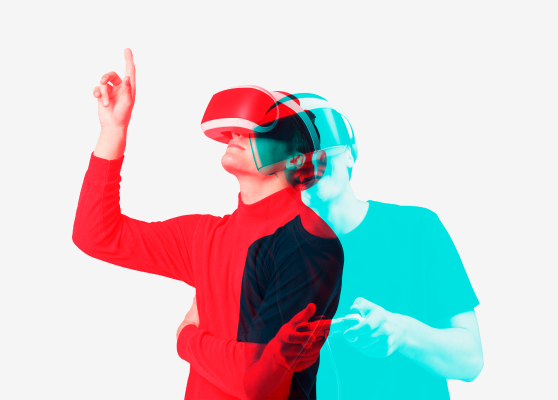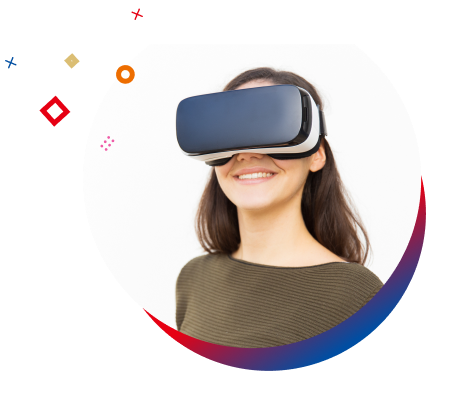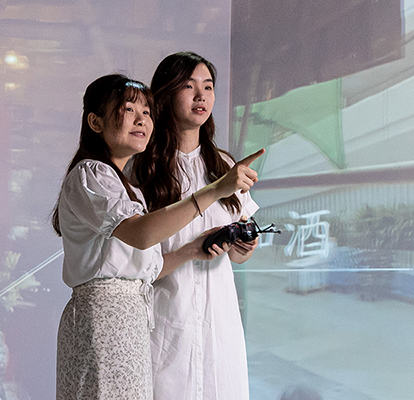

Immersive educational technology
Immersive technology is taking off in education with an increasing number of schools adopting this technology, allowing students to experience destinations from across the world without ever having to leave the classroom.
Learn MoreVirtual Reality (VR), Augmented Reality (AR), and Mixed Reality (MR)
Augmented reality (AR) adds digital elements to a live view often by using the camera on a smartphone. Examples of augmented reality experiences include Snapchat lenses and the game Pokemon Go, providing students with interactive and meaningful learning experiences. Virtual reality (VR) is a complete immersion experience that shuts out the physical world. Using VR devices such as HTC Vive, Oculus Quest or Google Cardboard, users can be transported into a number of real-world and imagined environments. In a VR setting, students can interact with what they see as if they were really there. In a Mixed Reality (MR) experience, which combines elements of both AR and VR, real-world and digital objects interact.
What are the benefits of immersive educational technology in education?
- Providing students with immersive learning experiences
- Providing the ability to inspire students’ creativity and spark their imaginations
- Motivating students to explore new academic interests.
- Helping students struggling to understand difficult academic concepts. For example, through AR, geometry students can check out 3D geometric forms from multiple perspectives; they can rotate a shape to see it from different angles and even view it from the inside.
- Cultural competence, the ability to understand another person’s culture and values—an important skill in today’s interconnected, global society. For example, a virtual reality field trip to other parts of the world, whether it be Peru or China, exposes students to cultures other than their own.
- Improving student outcomes, too. For example, in a March 2019 report, EdTech cites a study showing that students in a mixed reality biology classroom received higher scores than other students. AR and VR can help with memory retention and recall, as well—EdTech reports on a recent study that shows an increase in retention of almost 9 percent for students who learned in an immersive environment such as VR.

Immersive Educational Technology in Education: Resources and Tips
Bringing AR and VR tools into the classroom doesn’t have to be expensive. Available resources, ranging from low-priced viewers like Google Cardboard to cost-effective equipment that can connect to smartphones, can be acquired without breaking the bank. Resources for teachers include affordable or even free apps, such as 360Cities, which allows students to visit places like Rome and Tokyo. Another app, TimeLooper, allows students to visit locations through a historical lens, such as London in medieval times or World War II. Platforms like Immersive VR Education and Nearpod allow teachers to develop lesson plans with VR and AR technology. Our VR courseware application platform – EDVR, can also assist teachers to transform 360 videos (Learn More) into interactive teaching materials with a few clicks.
Ensure Ample Physical Space
To reap the benefits of virtual reality in education, it is important for students to use VR equipment safely. VR users often spin around or stride blindly, ignoring their physical surroundings. A misstep could lead to injury. Educators should ensure their classrooms’ physical environments are spacious and safe for VR explorers. Students should be at least an arm’s length away from each other and from objects in the classroom. When possible, use VR content that can be accessed by students sitting at their desks.
Supervise and Moderate VR Use in Classrooms
When incorporating VR technology into the classroom, it is crucial to supervise and moderate its use to ensure a safe and controlled environment. Establish clear guidelines including rules for movement and virtual object interaction. Monitor student engagement, encourage collaboration, and address technical issues promptly.
Develop a Plan for VR Learning
Among the most noteworthy benefits of virtual reality in the classroom is its ability to spark curiosity and interest in students. But left to their own devices, students may veer off topic. This is why educators should develop a structured plan to maximize the use of VR within lesson plans and then guide their students along the path. As part of the plan, it is important for teachers to determine goals and expectations for students and set guidelines for students to follow to ensure optimal learning experiences.
Teach Empathy and Cultural Competence
The magic of VR is that it brings different places throughout the world right into the classroom. These new perspectives can result in fostering empathy and cultural competence because they take students outside of their normal daily experience. The use of VR and AR helps students understand people’s unique situations across the world. For example, teachers can use VR applications to enhance language teaching by exposing students to the cultures of the people who speak the language. Using technology to build culturally responsive environments helps students respect cultures different from their own.
Free 3D Model Resources
| No | Website | Description | |
|---|---|---|---|
| 1. | Free3D | Free3D is a website offering a collection of free 3D models and assets. There are also paid options. | |
| 2. | Thingiverse | Thingiverse is an online platform for sharing and downloading free 3D printable files. | |
| 3. | Turbosquid | TurboSquid is a marketplace for 3D models, including both free and paid options. | |
| 4. | Sketchfab | Sketchfab is a website for sharing and viewing 3D models in real-time and virtual reality. Some of the models are downloadable. | |
| 5. | All3DFree | All3DFree is a website providing a selection of free 3D models for various applications. |

